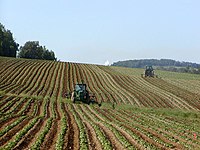
Photo from wikipedia
Abstract The objective of this field study was to evaluate the effects of crop rotation (rice-rice and soybean-rice) and rice cultivar selection (one hybrid and two pure-line cultivars) across two… Click to show full abstract
Abstract The objective of this field study was to evaluate the effects of crop rotation (rice-rice and soybean-rice) and rice cultivar selection (one hybrid and two pure-line cultivars) across two consecutive growing seasons (2012 and 2013) on methane (CH 4 ) fluxes and emissions from rice grown in the drill-seeded, delayed-flood production system on a silt-loam soil. Weekly CH 4 fluxes were measured from flooding to harvest from 30-cm-diameter, enclosed-headspace chambers at the Rice Research and Extension Center near Stuttgart, Arkansas. Averaged over years, area-scaled season-long CH 4 emissions were greater ( P 4 -C ha − 1 from Taggart and Cheniere, respectively), which did not differ, than from the hybrid CLXL745 following soybean (72.2 kg CH 4 -C ha − 1 ). Averaged across years and cultivars, yield-scaled season-long CH 4 emissions were greater ( P 4 -C [Mg grain] − 1 , respectively). Averaged across years and crop rotation, yield-scaled season-long CH 4 emissions were 77% greater ( P 4 emissions provide valuable data for future estimates of CH 4 emissions from the drill-seeded, delayed-flood production system on a silt-loam soil among crop rotation-cultivar combinations to refine greenhouse gas emissions estimates and evaluate anticipated climate change.
Journal Title: Geoderma Regional
Year Published: 2017
Link to full text (if available)
Share on Social Media: Sign Up to like & get
recommendations!